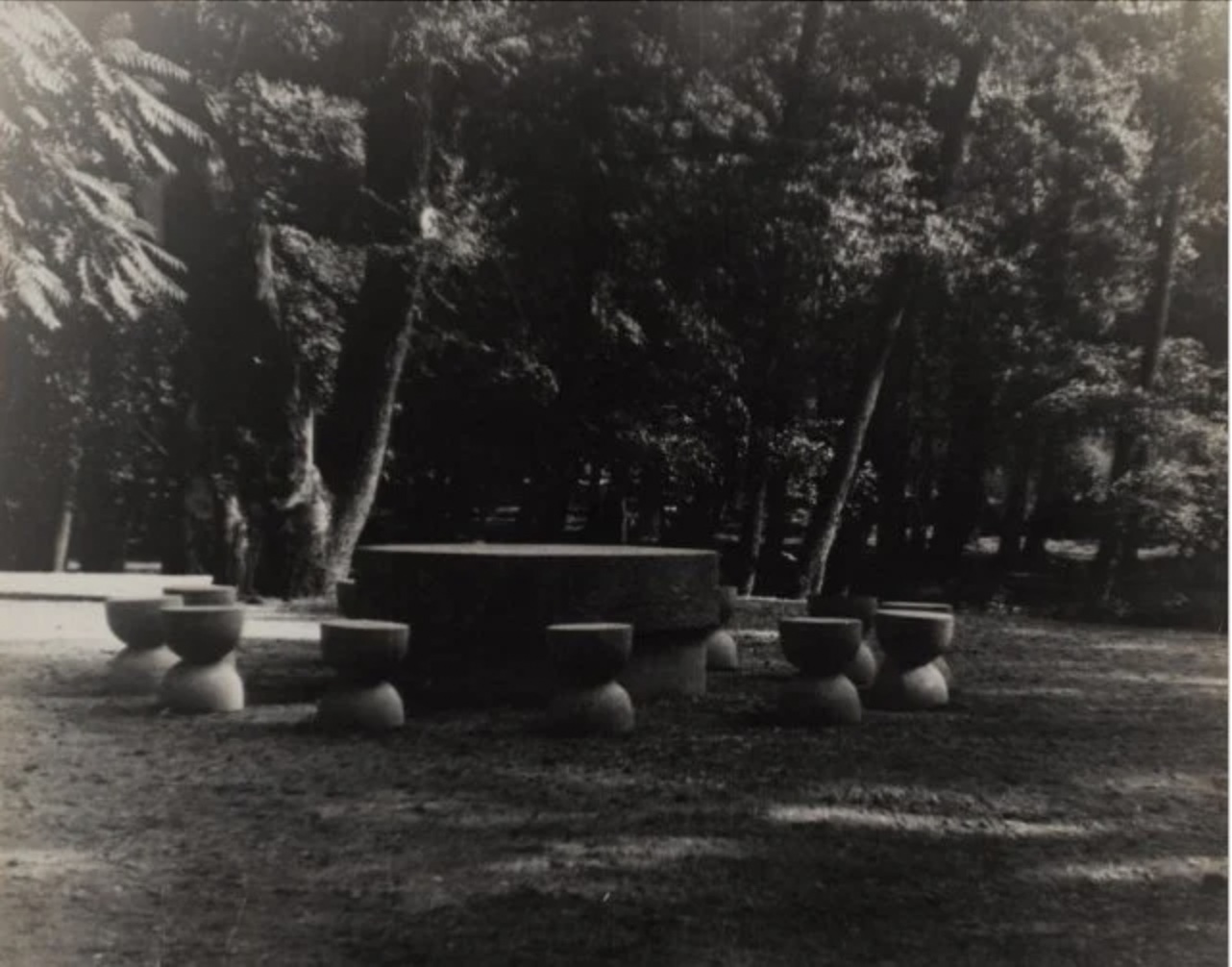Constantin Brâncuși (1875 - 1957)La Table du Silence á Târgu Jiu, Romania 1938.Gelatin silver print.24 x 29.8 cm (9 3/5 x 11 9/10 in.) ProvenancePrivate Collection LiteratureCarola Giedion-Welker, Constantin Brancusi, Editions du griffon, Neuchatel, 1958, p.168Jurgen Partenheimer, "Constantin Brancusi' : Der Kunstler als Fotograf seiner Skulptur", Kunsthaus Zurich, 1976, n.57Erika Billeter, Brancusi Als Fotograf, Benteli Verlag, Bern 1997, n.80Ion Pogorilovschi, "Comentarea Capodoperei, Ansamlul Sculptural Brancusi de la Tirgu-Jiu", Junimea, Romania, 1976, pl.41Doina Lemny, Brancusi Au-delá de toutes les Frontiéres, Fage Editions, Lyon, 2012, p. 93 Lot EssayOutside of the current lot, four other prints by Constantin Brancusi of La Table du Silence Tirgu Jiu, Romania 1938 are known to exist: three prints are held in the collection of the Centre George Pompidou, Paris and one print is owned privately. The Table of Silence, Târgu Jiu is one element of a three-part commissioned ensemble which together with the Gate of the Kiss and the Endless Column formed a poignant homage to local fallen heroes. The monument, commissioned by the Women?s League of Gorj, whose president was Aretia T?t?rescu, the Prime Minister?s wife, was to be a memorial to those who had lost their lives in 1916 defending the town against a German force. The commission had originally been offered to the sculptor Milita P?tra?cu, who was familiar with designing monuments but P?tra?cu, she had studied with Brancusi in Paris from 1919?23 and suggested that her friend and former teacher would be the person to undertake this honour. Brancusi accepted the commission and seems to have begun work in 1935.  In the Autumn of 1937, he began to carve the Table of Silence composed of a large plate superimposed on a smaller plate. The table is made of a porous limestone with the stools being made of a similar but finer stone. In 1938, not happy with the result he began a larger version of the first attempt ? Brancusi was still displeased and composed the final table which now stands in the park of the upper plate of the first attempt with the upper plate of the second attempt ? the discarded parts form another table placed elsewhere. The table is surrounded by 12 stools which are now situated about three feet from the table. The importance of the photograph as seen in the current lot cannot be underestimated as it shows a different placement and the working process of the artist ? we can see that there has been a change of mind and reflection afforded due to the opportunity to see his work via a photographic image, this follows Brancusi?s usual reliance on the camera as an intrinsic tool to hone his sculptures. The photograph shows the stools were originally much closer to the table and more closely paired than in the final work. We cannot say for sure why, whether for practical reasons or a wish to emulate the pairings of the lovers in the Gate of the Kiss we do not know. The table is however very much a stone version of the large plaster table in Brancusi?s studio, similarly versions of his studio table also served as the base for Leda, the Fish and the Seal. Brancusi?s attitude to the purpose of photography was in many ways contemporary ? he recognised it as immediate, flexible, versatile and above all he embraced its ability to produce multiples using this practice to replace the traditional drawing. He could satisfy his incessant need to make portraits of his works, using whatever camera he could lay his hands on. Not technically trained as a photographer, the prints Brancusi ?crafted? contain an indelible rawness and energy which is particular and individual. The proportion of negatives shot to the amount that were printed was far far greater making the prints extremely rare, with many now being held in museums rather than private collections. For Brancusi the portal of photography meant he could see his works in the making and if necessary, could then amend them no matter how large the subject as proven here.
Lots will be viewable from June 9th 2022 until midday on July 1st 2022 at our Lower Sloane Street Auction galleries (69 Lower Sloane Street, London, SW1W 8DA). The auction will be held close-by at 1400 GMT at the iconic Sir Christopher Wren building, Wren House, The Royal Hospital.
For our Terms & Conditions, please click here.
See Full Terms And Conditions


